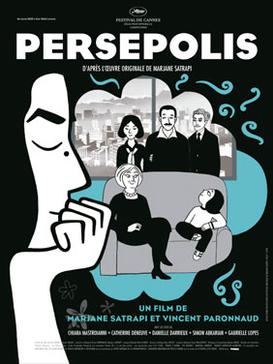
Persepolis is nothing if not ambitious. It almost defies labeling, because it is such a unique creature. It walks a thin line between comedy and drama. It is an animated film and contains flights of fantasy, but its characters and story are rooted firmly in reality. It is in some ways "artsy", with its stylistic animation and its mature storyline, but it always feels accessible. What is perhaps most surprising about the film, then, is that all of these elements come together and the film works beautifully.
Persepolis, based on a series of graphic novels, is a semi-autobiographical story about Marjane Satrapi, an Iranian woman who grows up during the late 70s and early 80s, a very turbulent time for Iran. She is witness to the revolt against the Shah regime, wars with Iraq, and other conflicts. At home and abroad, Marjane struggles with her Iranian identity, depression, an increasingly restrictive society, and of course love over the course of the film.
The animation of Persepolis is quite striking. The vast majority of the film is composed of hand-drawn* black and white animation. Although studios like Pixar deliver some fine computer-generated animation, it is refreshing to see a more traditional approach inPersepolis. The animation is particularly inspired during the historical interludes, in which rulers are portrayed as puppets being manipulated on a stage. But other images remained in my head. Long lines of soldiers shoot at each other across a ditch and then fall in, as the bodies pile up. Marjane and her boyfriend fly through the city in their car. Waves in the ocean are seen as massive swirls that gently bob up and down.
But perhaps the most compelling reason to watch Persepolis is simply its story. The film's characters are fully rounded, and the humanity of the story is compelling. Marjane's tale is essentially a coming-of-age story, but it never dissolves into cliché. Marjane's relationship with her grandmother, her disenchantment with the superficiality of European society, and her struggles with love all feel like the genuine conflicts of a real person. I fear, though, that I am making Persepolis sound too serious. The truth is that Persepolis finds great humor in Marjane's story. In one of my favorite scenes, an adolescent Marjane walks down a street in Iran past a line of shady looking men with trenchcoats, whom look like they could be drug dealers. But no, they are merely selling lipstick, nail polish, and Stevie Wonder CDs. In another scene, Marjane struts down the street, singing "Eye of the Tiger."
Persepolis succeeds not only as an animated movie but as a great film in itself. The film combines a compelling storyline with a striking visual style and is truly a must-see.
Verdict: A
*Note: I said the animation was hand-drawn, but it was most likely created and edited on a computer. Still, it looks hand-drawn, and the point still stands that it looks very different than anything the American animation studios are producing.
3 comments:
This makes me want to see the film. I very much like your framing of the movie in the opening paragraph
Stop being a better writer and more perceptive than your older brother! You're making me feel bad. But when I get home from Paris, can we watch a movie together? I'd really like that.
Thanks Dad and Austin! I really think both of you would like Persepolis quite a bit. And Austin, we definitely need to watch something. If I'm not wrong, I think that you and Matt have still yet to see Godfather Part II, which is a travesty. And they're showing it at the Brattle theater around Christmas time. Just an idea.
Post a Comment